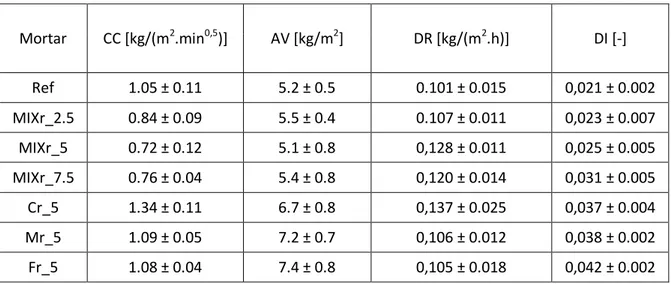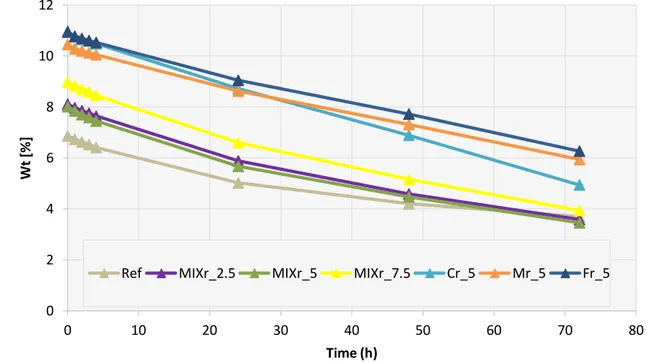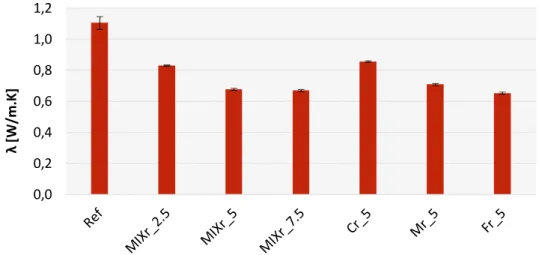NHL 3.5 MORTARS WITH SCRAP TIRE RUBBER
Faria, P.1*; Piteira, R.2*
1*
: ICIST, CERIS, Department of Civil Engineering, NOVA University of Lisbon Email: paulina.faria@fct.unl.pt
2*
: Department of Civil Engineering, NOVA University of Lisbon Email: r.piteira@campus.fct.unl.pt
Key words: Mortar; Rubber; Natural hydraulic lime; scrap tire rubber.
Abstract: The use of wastes and industrial by-products as building materials is an important issue in order to decrease costs with waste management and the embodied energy of building products. Scrap tire rubber has been studied as aggregate for cementitious materials. Natural hydraulic limes are natural binders with particular characteristics of both air and hydraulic binders. Their specifications became stricter with the last version of EN 459-1:2010. In this study scrap tire rubber was used as additional aggregate of mortars based on NHL3.5 and natural sand. Different particle size fractions and proportions of scrap tire rubber were used: a mix obtained almost directly from industry (only after sieving for preparation of particle sizes similar to mortar aggregate) and separated fine, medium and coarse fractions; 0%, 18%, 36% and 54% weight of binder, corresponding to 2.5%, 5% and 7.5% weight of sand. The influence of the rubber´s additions on the mortars´ fresh state, mechanical and physical performance is presented, namely by flow table consistency, water retention, fresh bulk density, dynamic elasticity modulus, flexural and compressive strength, open porosity and bulk density, capillary absorption, drying and thermal conductivity. The use of the rubber mix coming from the waste tire industry seems advantageous and may open possibilities for use as raw material by the mortars industry.
1
Introduction
The progress of technology brought to the society more requirements relative to living standards. Due to this improvement, there are direct environmental issues associated that did not exist a century ago. One of the biggest issues is the recycling of tires. This problematic is a big concern, because there are legal procedures that do not allow their fire burst in open air or its dump in landfills. Retreading companies try to avoid part of this problem, enlarging the life cycle of used tires, replacing the used tire tread for a new one. However, this procedure leads to another one: what to do with the scrap tire rubber waste? These companies agglomerate the waste and have very little use to it (IGAOT 2007). In recent years, the construction field tried to apply this waste in various manners, such as pavements (artificial turfs or roads), cementitious mortars (Eiras et al. 2014) and concrete (Thomas et al. 2014). Studies performed on scrap tire rubber concluded that the rubber is an elastic waste that can provide some deformability and improve thermal characteristics to cement-based mortars, although the mechanical characteristics could be compromised (Al–Akhras et al. 2002).
Natural hydraulic limes (NHL) are natural binders with particular characteristics of both air and hydraulic binders, that can be very beneficial in several types of application, namely when applied on the rehabilitation of buildings. NHL specifications became stricter with the last version of EN 459-1 (CEN 2010a) and some limes previously named NHL have been reclassified as natural lime HL. EN 459-1 NHL are only produced in few countries of the world, namely in Portugal. Because of the previous reasons the study of the properties of natural hydraulic lime NHL 3.5 mortars have recently regain the interest of the scientific community (Grilo et al. 2014a; Grilo et al. 2014b).
them characterize cement-based mortars. The present study addresses the mechanical and hygrothermal characteristics of natural hydraulic lime mortars with scrap tire rubber as additional aggregate. The mechanical tests undertaken are the dynamic elasticity modulus, compressive and flexural strength, while hygrothermal tests performed are thermal conductivity, capillary absorption and drying. All of the mortars were prepared in laboratory and used the same type and proportions of NHL and sand, even though the particle size and proportion of the added scrap tire rubber changed.
1.1
Materials, mortars and samples
It was initially defined that the mortars would only contain natural hydraulic lime, siliceous sand and scrap tire rubber waste, in addition to the mix of NHL and sand. No admixtures were used. The binder used was a natural hydraulic lime NHL 3.5 produced by SECIL Argamassas and will be named NHL. Their chemical characterization has been published elsewhere (Grilo et al. 2014a) and the loose bulk density is presented in Table 1. The sand was a mix of four different natural siliceous sands with variable particle size, to achieve a particle size distribution that can be observed in Figure 1. The loose bulk density of the sand is presented in Table 1. The scrap tire rubber waste was provided by
the retreading company BANDAGUE. Since the rubber waste had different sizes and forms, it was
previously sieved and only the particles below 2.36 mm were used. The remaining rubber waste was abdicated in this stage of the study because of the small size of the samples to be prepared and tested. The particle size distribution of the rubber waste fraction below 2.36 mm (designated as MIXr) was performed and can be observed in Figure 1. With the results of the particle size distribution of the rubber waste, it was decided also to divide it into the following fractions:
coarse rubber waste, Cr, which includes the particles under 2.36 mm and above 0.6 mm;
medium rubber waste, Mr, with particles between 0.6mm and 0.212 mm;
fine rubber waste, Fr, with particles under 0.212 mm.
From the global sample MIXr the percentage of each fraction was 1.5% of Fr, 27.5% of Mr and 71% of Cr. The dosage of each fraction when the mixture of rubber MIXr was used was calculated according to these percentages. The loose bulk density of each type of rubber waste is presented in Table 1. The MIXr was added to the mortar´s formulation on percentages of 0% (reference mortar), 18%, 36% and 54% of NHL weight, corresponding to 2.5%, 5% and 7.5% of the weight of the sand. Other mortars formulations had an addition of 36% of the NHL weight (5% of the sand weight) of only the Fr, Mr and Cr fractions of the rubber waste.
Figure 1 – Particle size distribution of the sand and the scrap tire waste fractions
Table 1 – Loose bulk density of the mortar´s components
Material NHL Sand MIXr Cr Mr Fr
Loose bulk density [kg/m3] 688 1643 352 289 341 286
Table 2 – Weight proportion of the mortars and water/NHL ratio
Mortar NHL Sand Scrap tire rubber W/NHL
Fr Mr Cr MIXr
Ref 1 7.2 - - - - 1.2
MIXr_2.5 1 7.2 0.2 1.3
MIXr_5 1 7.2 0.4 1.3
MIXr_7.5 1 7.2 0.5 1.4
Cr_5 1 7.2 - - 0.4 - 1.3
Mr_5 1 7.2 - 0.4 - 1.3
Fr_5 1 7.2 0.4 - - - 1.5
The production of the mortars was based on EN 1015-11 (CEN 1999/2006), but with some particularities that has been used currently in the laboratory of NOVA University of Lisbon with NHL mortars with additions (Grilo et al 2014a). The process was made by initial manual homogenization of the dry components and water addition during the first seconds of mechanical mixing. After two
0 10 20 30 40 50 60 70 80 90 100
0,01 0,1 1 10
P
a
ssi
n
g
[
%
]
Grain size [mm] Cr
Mr
Fr
MIXr
and a half minutes of the mechanical mixing, the mortar on the borders of the ball was incorporated during a stop of 30 seconds and the mortar´s preparation was finished after a last period of 30 seconds of mechanical mixing. After this process, the fresh state characterization was performed and two types of samples were produced: cylindrical samples, with 90 mm of diameter and 20 mm high, and prismatic samples with 40 mm x40 mm x160 mm. The samples were let dry in stable laboratory
conditions (20±3⁰C of temperature and 65±5% of relative humidity) during 28 days.
2
Methods and analysis of results
2.1
Fresh state characterization
The characterization of the mortars in the fresh state included the experiments of consistency by flow table test, based on EN 1015-3 (CEN 1999/2004/2006), bulk density, based on EN 1015-6 (CEN 1998/2006), and water retention test, based on prEN 1015-8 (CEN 1998). Results are shown in Table 3.
Table 3 – Fresh state characterization of mortars
Mortar Flow Table
[mm]
Bulk Density
[kg/m3]
Water Retention [%]
Ref 166 2073 85.4
MIXr_2,5 172 1947 86.8
MIXr_5 167 1863 86.1
MIXr_7,5 170 1816 85.8
Cr_5 171 1906 83.1
Mr_5 173 1834 85.9
Fr_5 169 1807 86.7
2.2
Mechanical characterization
To evaluate the mechanical characteristics the campaign involved the dynamic elasticity modulus, based on EN 14146 (CEN 2004), flexural and compressive strength, based on EN 1015-11 (CEN 1999/2006). The compressive rupture can be observed in Figure 2 and mechanical results can be observed in Figure 3.
Figure 2 – Compressive rupture of NHL-rubber mortar sample at 28 days
Figure 3 – Flexural strength FS, compressive strength Cs and dynamic elasticity modulus Ed at 28 days
It is possible to observe that the addition of rubber wastes decreases the mechanical properties.
As for the dynamic elasticity modulus, it decreases with the increase of the percentage of added rubber, and also with the decrease of the particle size of that waste, similarly to what happened with the flexural strength. The dynamic elasticity modulus of mortars MIXr and Mr are quite comparable. Considering that a high flexural strength and a low dynamic elasticity modulus would be advantageous to assure deformability and resistance to cracking, it can be seen in Figure 4 that the mortar MIXr_5 (which also presented the higher compressive strength among the ones with rubber waste) registered the highest ratio Fs/Ed.
Figure 4 – Flexural strength/dynamic elasticity modulus ratio at 28 days
2.3
Open porosity and hardened bulk density
For better understanding of the mortars behaviour, their open porosity and the hardened state bulk density were determined by vacuum and hydrostatic weighting, based on EN 1936 (CEN 2006). Results are shown in Table 4.
Table 4 – Open porosity and bulk density after 28 days
Mortar Porosity[%] Dens. [kg/m
3 ]
Average StDv Average StDv
Ref 21.9 0.3 1924 4
MIXr_2.5 21.7 0.3 1788 12
MIXr_5 23.2 0.9 1657 52
MIXr_7.5 23.2 0.4 1653 6
Cr_5 23.4 0.6 1737 28
Mr_5 23.1 0.4 1709 9
Fr_5 23.3 0.3 1645 7
9 9,5 10 10,5 11 11,5 12
(Fs
/E
d
) x
10
5 [
The open porosity does not change too much, increasing only 1-2%. Nevertheless it can be observed that the addition of rubber waste generally increases the porosity. The results of the bulk density in the hardened state are similar to the ones obtained from the fresh state. This means that the bulk density decreases with the increasing amount of rubber waste in the mortars and also with the decreasing size of their particles.
2.4
Capillary absorption and drying
Capillary absorption experiment was based on EN 15801 (CEN 2009) and EN 1015-18 (CEN 2002). The prismatic samples were cut down to cubes with 40 mm edges. To ensure waterproof in the lateral faces, they were covered with an epoxy resin. The results are expressed by capillary curves, with the capillary absorption function of the square root of time. The capillary curves allow the determination of capillary coefficient, calculated by the slope of the more representative initial segment of the curve of each mortar, and the asymptotic value of capillary which expresses the total amount of
absorbed water. The capillary curves are presented in Figure 5 and the capillary coefficients and
asymptotic values can be analyzed in Table 5.
Figure 5 – Capillary water absorption curves at 28 days 0
1 2 3 4 5 6 7 8
0 20 40 60 80 100
Ca
p
illa
ry
a
b
so
rp
tio
n
[
k
g
/m
2]
Time (min 0,5)
Table 5 – Capillary coefficients CC, asymptotic value of capillary AV, drying rate DR and drying index DI after 28 days (average and standard deviation)
Mortar CC [kg/(m2.min0,5)] AV [kg/m2] DR [kg/(m2.h)] DI [-]
Ref 1.05 ± 0.11 5.2 ± 0.5 0.101 ± 0.015 0,021 ± 0.002
MIXr_2.5 0.84 ± 0.09 5.5 ± 0.4 0.107 ± 0.011 0,023 ± 0.007
MIXr_5 0.72 ± 0.12 5.1 ± 0.8 0,128 ± 0.011 0,025 ± 0.005
MIXr_7.5 0.76 ± 0.04 5.4 ± 0.8 0,120 ± 0.014 0,031 ± 0.005
Cr_5 1.34 ± 0.11 6.7 ± 0.8 0,137 ± 0.025 0,037 ± 0.004
Mr_5 1.09 ± 0.05 7.2 ± 0.7 0,106 ± 0.012 0,038 ± 0.002
Fr_5 1.08 ± 0.04 7.4 ± 0.8 0,105 ± 0.018 0,042 ± 0.002
The mortars with MIXr present lower capillary coefficients, CC, than the ones with only one fraction of rubber and even lower than the reference mortar, what is very positive. The tendency is a decrease on CC with the MIXr addition and with the decrease of particle size of the waste. The MIXr_5 mortar presents the lowest CC, very close to the MIXr_7.5 mortar. As for the capillary water absorption, MIXr_5 presents the lowest asymptotic value, close to the reference mortar, while all the others present higher capillary water absorption. Although MIXr mortars absorb total quantities of water that are similar to the reference mortar, mortars with separated fractions of waste absorb a higher amount of water. This factor increases as the particle size decreases.
Figure 6 - Drying curves of mortars after capillary absorption
The drying rate, DR, represents the initial drying speed calculated by the slope of the initial segment of each drying curve, and the drying index, DI, represents how hard for each mortar is to achieve a complete dry equilibrium. Drying index was determined at 700 h of test, when the percentage of moisture was close to equilibrium with the environment, and a simplified expression was used (Grilo et al., 2014b). Both DR and DI are presented in Table 5.
All the mortars present a higher DR than the Ref mortar. This means that a fast drying occur what, particularly in singular fraction waste mortars, would compensate a fast absorption on mortars with added rubber. Mortars Cr_5 and MIXr_5 present the highest DR. The drying index values are all very similar, although they are all higher than the Ref mortar, indicating a lower total drying capacity. DI increases with the addition of rubber waste and with the decrease on the particle size of the waste.
2.5
Thermal Conductivity
This experiment was performed on the cylindrical samples with 90 mm diameter and 20 mm high. A Heat Transfer Analyzer Isomet 2104 equipment was used to estimate the thermal conductivity of the mortars, with a circular 60 mm probe. Results are presented in Figure 7.
0 2 4 6 8 10 12
0 10 20 30 40 50 60 70 80
Wt
[
%
]
Time (h)
Figure 7 - Thermal conductivity of mortars at 28 days
As the percentage of rubber waste increases, the thermal conductivity decreases and it decreases also with the decrease of rubber waste size fraction. The tendency is exactly the same that had previously been detected for the bulk density.
3
Conclusions
Based on the experimental campaign that has been presented it is possible to conclude that:
• It was possible to formulate mortars with good workability with the addition of different
proportions and different particle size fractions of scrap tire rubber waste; nevertheless, the introduction of the rubber waste leads to the need of more water/NHL ratio to maintain the level of workability.
• All the mortars with waste rubber addition are lighter than the reference mortar, which
justifies the decrease of bulk density; that is due to the fact that the volumes of rubber wastes (with low loose bulk density when compared to the sand and even to the NHL) is not occupied by the binder:sand paste.
• The introduction of scrap tire rubber wastes causes a decrease in mechanical characteristics
of mortars, namely compression and flexural strengths and dynamic elasticity modulus; nevertheless the compressive strength of mortar with 5% of MIXr is higher than 1 MPa.
• Although the decrease on mechanical characteristics with the addition of rubber waste, the
dynamic elasticity modulus decrease means that the mortars are more deformable and, in fact, the flexural strength/dynamic elasticity modulus ratio is very positive for most of the mortars with rubber waste and particularly for the mortar with 5% of MIXr.
• Open porosity is slightly higher (up to 2%), which means that the introduction of rubber
waste may induce more or bigger pores; that fact should be further investigated analyzing the rubber waste and the rubber-mortar microstructures.
• Mortars with addition of MIXr have lower capillary coefficients than the reference mortar,
and particularly the mortar with 5% of MIXr present a slow capillary absorption; also this fact may found deeper explanation when testing the rubber-mortar microstructure: most probably it occurs because the addition of mix rubber waste changes the porous structure of the mortars, making it less capillary, what is very positive.
0,0 0,2 0,4 0,6 0,8 1,0 1,2
λ
[
W/m
.K
• All the mortars with addition of rubber waste present a faster initial drying than the reference mortar, what would contribute for an easy evaporation of the absorbed water.
• The thermal conductivity decreases with the addition of rubber waste showing the same
trend of bulk density.
In face of the results, it seems that the use of the rubber mix waste, MIXr, coming from the scrap tire industry seems advantageous and may open possibilities for use as raw material by the mortars industry. The addition of 5% of the sand weight seems particularly promising. Further characterization of the rubber waste mortars is going on, namely in terms of microstructure and toxicity by chemical leaching. Bearing in mind the type of applications and the requirements that are defined by standards (namely by EN 998-1 and 2 (CEN 2010b; CEN 2010c) for mortars), the formulations can be further optimized.
The chemical leaching, together with already obtained results for mortars, will allow defining possibilities of application, for instance as based layers of renders and plasters, as masonry mortars or as intermediate screeds. For this last type of application, particles over 2.36 mm would be interesting, no previous sieving would be needed and any fraction of the rubber waste would be rejected.
4
Acknowledgments
Acknowledgments are due to Vitor Silva for helping in the experimental campaign, to BANDAGUE Lda for the scrap tire waste and to SECIL ARGAMASSAS for the NHL3.5.
5
References
Al-Ahkras N., Smadi M. (2004), Properties of tire rubber ash mortar. Cement and Concrete Composites 26, 821-826.
CEN (2010a), EN 459-1:2010 – Building lime. Definitions, specifications and conformity criteria.
Brussels.
CEN (2010b), EN 998-1 - Specification for mortar for masonry. Part 1: Rendering and plastering
mortar. Brussels.
CEN (2010c), EN 998-2 – Specification for mortar for masonry. Part 2: Masonry mortar. Brussels.
CEN (2006), EN 1936 – Natural stone test methods. Determination of real density and apparent
density, and of total and open porosity. Brussels.
CEN (1999/2004/2006) EN 1015-3/A1/A2 – Methods of test for mortar for masonry. Part 3:
Determination of consistence of fresh mortar (by flow table). Brussels.
CEN (1998/2006), EN 1015-6/A1 - Methods of test for mortar for masonry. Part 6: Determination of
bulk density of fresh mortar. Brussels.
CEN (1998), prEN 1015-8 - Methods of test for mortar for masonr.y Part 8: Determination of water
retentivity of fresh mortar. Brussels.
CEN (1999/2006), EN 1015-11/A1 - Methods of test for mortar for masonry. Part 11: Determination of
flexural and compressive strength of hardened mortar. Brussels.
CEN (2002), EN 1015-18 – Methods of test for mortar for masonry. Part 18: Determination of
CEN (2004), EN 14146 – Natural stone test methods. Determination of dynamic elastic modulus of
elasticity (by measuring the fundamental resonance frequency). Brussels.
CEN (2009), EN 15801 – Conservation of cultural property. Test methods. Determination of water
absorption by capillarity. Brussels.
CEN (2013), EN 16322 – Conservation of cultural heritage. Test methods. Determination of drying
properties. Brussels.
Eiras J., Segovia F., Borrachero M., Monzó J., Bonilla M., Payá J. (2014), Physical and mechanical properties of foamed Portland cement composite containing crumb rubber from worn tires. Materials and Design 59, 550-557.
Grilo J, Santos-Silva A, Faria P, Gameiro A, Veiga R, Velosa A (2014a), Mechanical and mineralogical properties of natural hydraulic lime-metakaolin mortars in different curing conditions. Construction and Building Materials 51, 287-294.
Grilo J, Faria P, Veiga R, Santos-Silva A, Silva V, Velosa A (2014b), New natural hydraulic lime mortars. Physical and microstructural properties in different curing conditions. Construction and Building Materials 54, 378-384.
IGAOT (2007), Relatório temático sobre o resultado das inspecções a indústrias de reconstrução de pneus (recauchutagem). Ministério do Ambiente, do Ordenamento do Território e do Desenvolvimento Regional. Lisboa.
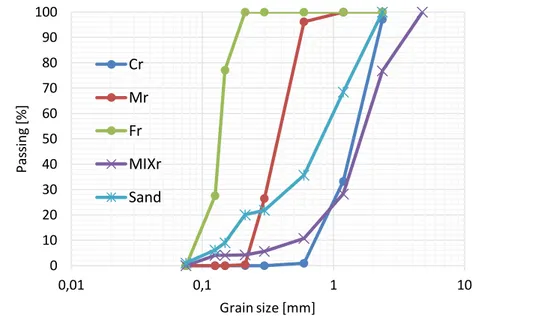
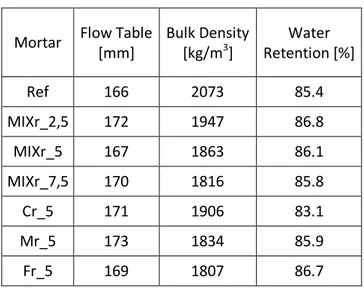
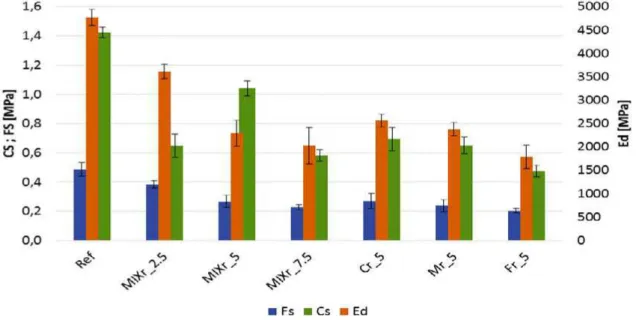
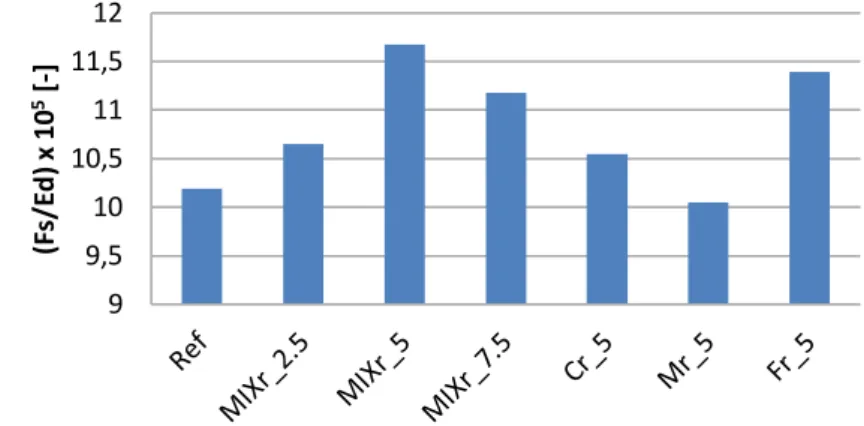
![Figure 5 – Capillary water absorption curves at 28 days 0 1 2 3 4 5 6 7 8 0 20 40 60 80 100 Capillary absorption [kg/m2] Time (min 0,5) Ref MIXr_2.5 MIXr_5 MIXr_7.5 Cr_5 Mr_5 Fr_5](https://thumb-eu.123doks.com/thumbv2/123dok_br/16622810.740250/7.892.126.772.527.843/figure-capillary-water-absorption-curves-capillary-absorption-time.webp)
